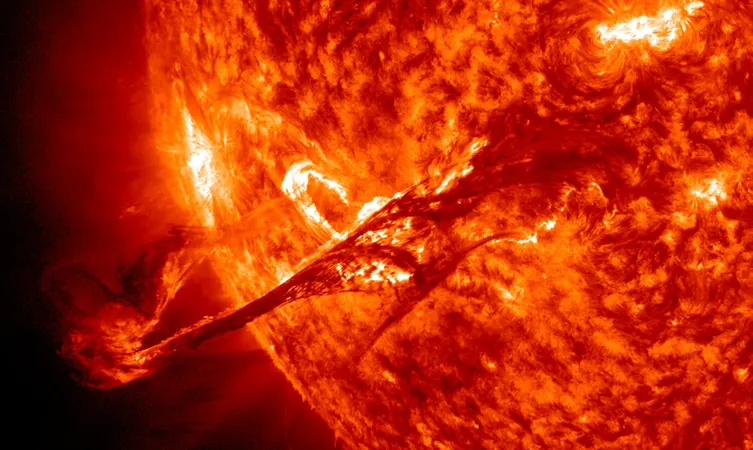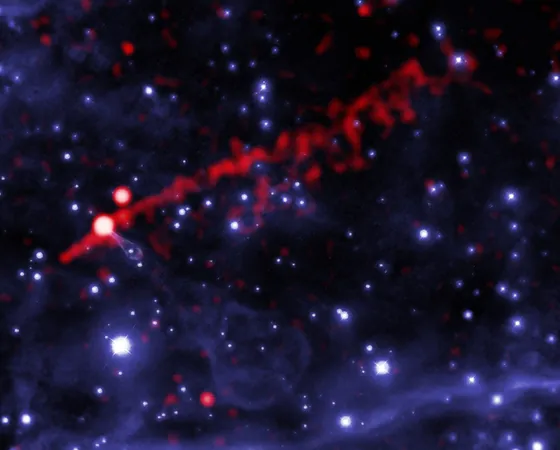
Unearthing the Secrets of Ancient Woods: What Tree-Rings Reveal About Catastrophic Solar Storms
2024-11-21
Author: Emma
Introduction
This year's stunning display of the Northern Lights was seen unusually far south, sparking excitement across social media platforms. But what if I told you that there’s a possibility of witnessing an aurora so brilliant that it would render all smartphones useless? That’s the reality during massive solar storms, which are rare yet devastating phenomena that can unleash a torrent of solar particles toward Earth.
The Historical Context
Such extreme solar storm events have been documented only six times over the past 14,500 years, with the last recorded occurrence happening around 664 B.C., during a time when the Assyrian Empire thrived. A research team, led by Dr. Irina Panyushkina from the University of Arizona's Laboratory for Tree-Ring Research alongside Dr. Timothy Jull from the Department of Geosciences, has successfully identified this elusive event, providing crucial insight into our sun's violent behavior.
Research Findings
Published in *Communications Earth & Environment*, their groundbreaking findings stem from an innovative analysis of carbon-14 levels found within tree rings. These carbon isotopes, produced when cosmic radiation interacts with the Earth's atmosphere, reveal spikes that correlate with intense solar activity. Dr. Panyushkina emphasizes the importance of pinning down the timing of such eruptions, which enhances scientists’ understanding of solar activity and its long-term impacts on Earth.
Methodology
Carbon-14 forms when radiation from cosmic events interacts with atmospheric gases, gradually getting absorbed by trees as they grow. The researchers employed surgical knives to carefully extract tree-ring samples from ancient wood, including specimens from old trees buried in sediment and archaeological sites. The cellulose in these wood samples was then incinerated to measure radiocarbon content accurately.
Synergistic Analysis
In a classic case of synergy, the team also cross-referenced the tree-ring data with levels of beryllium-10, another isotope created by solar particles that get trapped in polar ice cores. According to Dr. Panyushkina, the synchronous spikes in both carbon-14 and beryllium-10 indicate a solar storm occurred during a specific period, reinforcing the link between tree rings and historical solar activity.
Implications for the Future
The historical implications of such research are profound. If a similar solar storm hit Earth today, we would face catastrophic repercussions—widespread power outages, disrupted communication systems, and satellite failures could become commonplace. Experts stress that understanding these historical events is crucial for preparing for potential future occurrences.
Conclusion
While the tree-rings act as valuable natural records of these Miyake events, Dr. Panyushkina notes that the patterns remain elusive, making predictions about future solar activity difficult. Nevertheless, the insights from their research could fundamentally alter our comprehension of solar events' roles in shaping our planet.
In essence, the team's pioneering work is not just unearthing facts about our sun's past; it also raises questions about how such solar storms could influence Earth's future. As we continue to grapple with our dependence on technology, the shadow of these ancient cosmic events looms large, reminding us of the unpredictable forces at play in our universe. Will we be ready when the next storm strikes?









 Brasil (PT)
Brasil (PT)
 Canada (EN)
Canada (EN)
 Chile (ES)
Chile (ES)
 España (ES)
España (ES)
 France (FR)
France (FR)
 Hong Kong (EN)
Hong Kong (EN)
 Italia (IT)
Italia (IT)
 日本 (JA)
日本 (JA)
 Magyarország (HU)
Magyarország (HU)
 Norge (NO)
Norge (NO)
 Polska (PL)
Polska (PL)
 Schweiz (DE)
Schweiz (DE)
 Singapore (EN)
Singapore (EN)
 Sverige (SV)
Sverige (SV)
 Suomi (FI)
Suomi (FI)
 Türkiye (TR)
Türkiye (TR)